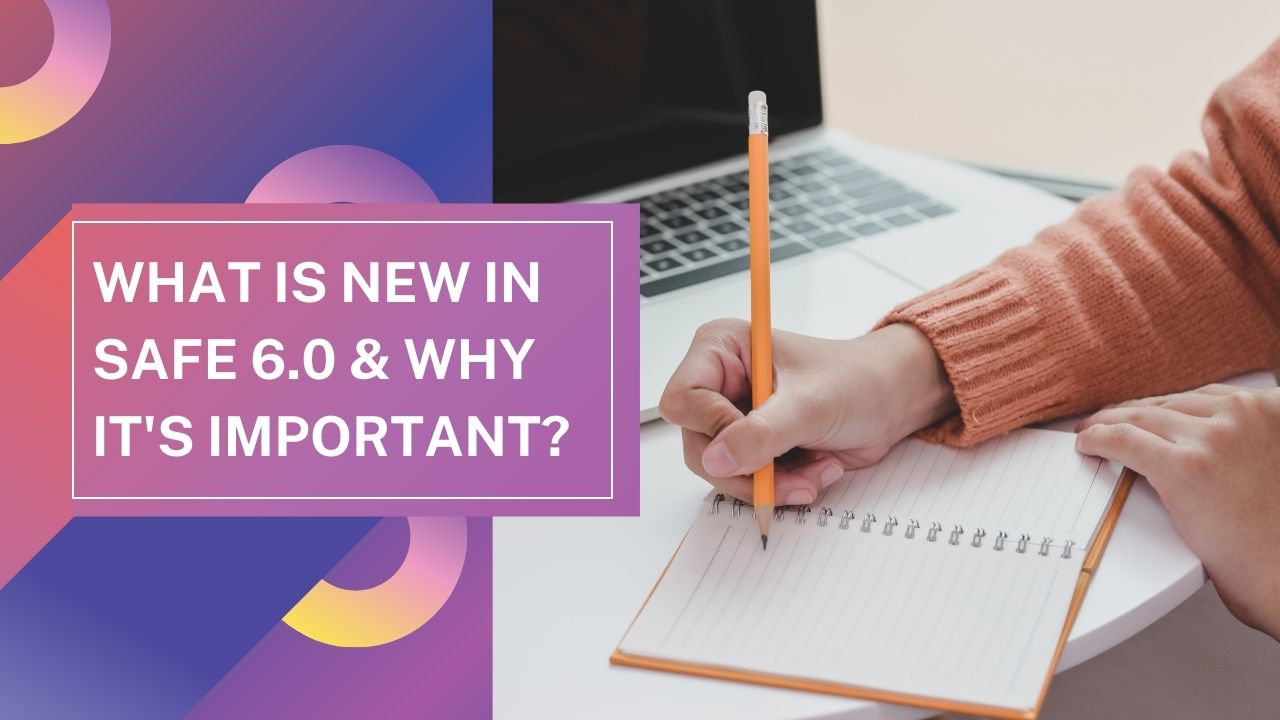
The terminology and organizational structure have undergone several relatively minor changes, as well as a few significant ones that may have an impact on how businesses use SAFe and how SAFe partners, trainers, and consultants—including our sizable team of SAFe experts—train and coach these businesses.
On March 15th, the Scaled Agile Framework’s most recent version, 6.0, was released.
SAFe 6.0 – The Revisioned Big Picture


We advise going directly to the source by visiting the official “What’s New?” page at the SAFe website for a complete list of changes along with in-depth explanations and illustrations.
Scaled Agile Inc. (SAI) categorizes the 6.0 upgrades generally into the following six groups:
- Strengthening the foundation for business agility
- Empowering teams and clarifying responsibilities
- Accelerating value flow
- Enhancing business agility with SAFe across the business
- Building the future with AI, Big Data, and Cloud
- Delivering better outcomes with Measure and Grow, and OKRs
Strengthening the foundation for business agility:
The updates to the core components of business agility, such as the SAFe Foundation and Business Agility Value Stream, are one of the significant changes in SAFe 6.0. These adjustments make the way to navigate the transition clearer and give a more thorough understanding of the fundamental ideas behind business agility.
A new feature of SAFe 6.0 that helps to clarify what business agility entails is the Business Agility Value Stream. The stages taken to develop a minimum viable product (MVP), validate it, produce it, and deliver a market opportunity are shown in the value stream. This value stream helps participants understand business agility and offers a more organized method of delivering business value. It is crucial to remember that, depending on the business context, the example value stream provided might need to be further extended. For instance, business agility delivery in some circumstances may involve:
Training customer support employees.
Developing new partners.
Dealing with the operational Support
The six Lean principles that form the framework’s core Lean philosophy have also been expanded upon in SAFe 6.0. This explanation offers a more in-depth breakdown of fundamental principles, making it simpler for everyone to comprehend them.
SAFe 6.0 has expanded several SAFe principles, most notably the sixth principle, which emphasizes flow. The new content includes flow diagnosis tools that help organizations better understand and improve their flow. Additionally, this principle is now elaborated at all levels of SAFe, stressing its centrality to the framework.
The SAFe Implementation Roadmap and the SPC (SAFe Program Consultant) role have both undergone changes in SAFe 6.0. The Implementation Roadmap, which has been revised to take into account the changes in SAFe 6.0, outlines key steps for implementing the framework. Roles have been further streamlined, and more implementation toolkits have been added. In particular, the Implementation Roadmap is only one aspect of SPC’s function. SPCs are now expected to coach the flow and boost business agility, underscoring the significance of their role in assisting enterprises in doing so.
Empowering teams and clarifying responsibilities
Several Agile practitioners have built successful careers around developing knowledge in the roles and responsibilities described in SAFe since they are an essential component of the broader framework. Many of these duties have been made clearer with version 6.0, which ought to make their work even simpler and more efficient. Although almost all of the roles and ideas have been modified to conform to the new framework, the following modifications are the ones we think are the most significant:
The job of Scrum Masters (now officially known as “Team Coaches”) has been broadened to encompass enhancing flow, creating high-performing teams, and fostering organizational agility. To reflect the crucial collaborations needed to support effective product development flow, changes were made to the roles of system architect, solution architect, product manager, and solution manager.
Accelerating value flow
The framework now outlines eight properties of flow and eight associated accelerators to make value flow more quickly, expanding on the significance of the new SAFe Principle (#6):
The eight properties of flow and the eight flow accelerators from Principle #6 are described in new section headers on The Big Picture called Team Flow, ART Flow, Solution Train Flow, and Portfolio Flow.
Clarifications regarding the use of a Kanban (now known as a SAFe Team Kanban) will aid individual teams in improving the flow of value through the ART.
Value Stream Management is now legally acknowledged as a crucial Portfolio-level responsibility
The Value Management Office (VMO), which once supported understanding, measuring, and optimizing the flow of value, has changed its name and focus.
Enhancing business agility with SAFe across the business
We have always thought that agility should govern workflows across the entire organization, not just in IT. SAFe 6.0 enablement information now contains a far more substantial knowledge base surrounding how to make that happen. For example,
A new “Business and Technology” article highlights five patterns—business-enabled ARTs, launching business trains, creating an Agile executive team, applying SAFe to other business functions, and combining development and operational value streams within the same portfolio—that help support full-scale business agility.
A new “SAFe Beyond IT” home page curates articles written by pros in the trenches to highlight how they’ve effectively deployed SAFe outside IT.
Building the Future with AI, Big Data, and Cloud
SAFe has released new guidelines for integrating the three transformative technologies of AI, Big Data, and Cloud in software and system development. These technologies are increasingly crucial for businesses to compete in the present and future. The papers in SAFe provide extensive explanations of these technologies and explain how they can be applied inside the framework.
The three revolutionary technologies of AI, Big Data, and Cloud have been included in revised SAFe principles for incorporating them into software and system development. These technologies are increasingly vital for firms to compete in the present and future. The articles in SAFe provide thorough explanations of these technologies and describe how they can be applied inside the framework.
Delivering better outcomes with Measure and Grow, and OKRs
Despite mostly vocabulary and organizational changes, SAFe 6.0 has strengthened the framework’s emphasis on metrics, OKRs, and making data-driven decisions—a notion we consistently educate our clients.
As Scaled Agile Inc.’s trusted advisors and partners, we are continuing to learn about and implement these SAFe 6.0 updates. As such, we will update and add to this article. Please get in touch with an expert if you have any questions.








